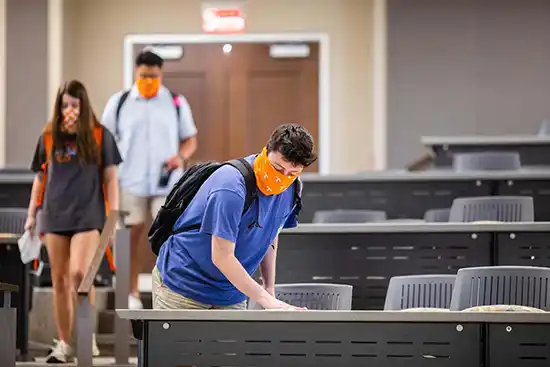Disease-Resistant Design Closer to Reality

A series of research collaborations by two faculty members of the Department of Civil and Environmental Engineering in the University of Tennessee, Knoxville’s Tickle College of Engineering, Professor Qiang He and Assistant Professor Shuai Li, is working to reduce the impact of pathogens—including the COVID-19 virus—within the built environment.
Now, with projects funded by two new grants from the National Science Foundation, the researchers are continuing their mission of developing disease-resistant infrastructure solutions.
The first project, “Toward Disease-Resistant School Communities by Reinventing the Interfaces among Built Environments, Occupants, and Microbiomes,” is a one-year, $150,000 project that leverages an area of NSF’s Big Ideas initiative: “Harnessing the Data Revolution.”
“The goal of this project is to develop intelligent technologies to model and monitor the environment–occupant–microbiome interactions in school communities to help school managers prevent the spread of infectious diseases,” said He. “We hope to lay a computational foundation for design and operational control by linking microbial contamination patterns and transmission pathways with quantifiable design attributes and operation paradigms.”
The second project, “Bio-socially Adaptive Control of Robotics-Augmented Building-Human Systems for Infection Prevention by Cybernation of Pathogen Transmission,” is a three-year, $1.2 million study that aims to develop new techniques to monitor and predict pathogen spreading, automate building ventilation, enable intelligent recognition of contaminated objects, and perform precision disinfection to reduce pathogen transmission through air circulation and surface contacts.
With this longer-term study, the researchers intend to advance the understanding of linkages among the physical, biological, and social processes that drive the dynamics of human–pathogen interactions in buildings and to develop a novel cyber–physical system of integrated monitoring, building control, robot adaptation, and human-in-the-loop interactions to reduce the transmission of infectious pathogens.
“This research pioneers a novel approach that integrates building information modeling, privacy-preserving Internet of Things sensing, spatiotemporal molecular and metagenomic sequencing, and machine learning to map building–human–pathogen interactions for predicting contamination and infection risks at multiple spatiotemporal scales,” said Li. “New methods will be developed to connect and manage the buildings, occupants, and robots to reduce pathogen burdens.”
Findings from the project will guide occupants and facility managers to develop and implement effective behavioral interventions and hygiene practices. If successful, this research will revolutionize the control of built environments to enable protection against infectious diseases, resulting in vast public health and economic benefits to the nation.
The post "Disease-Resistant Design Closer to Reality" appeared first on news.utk.edu
